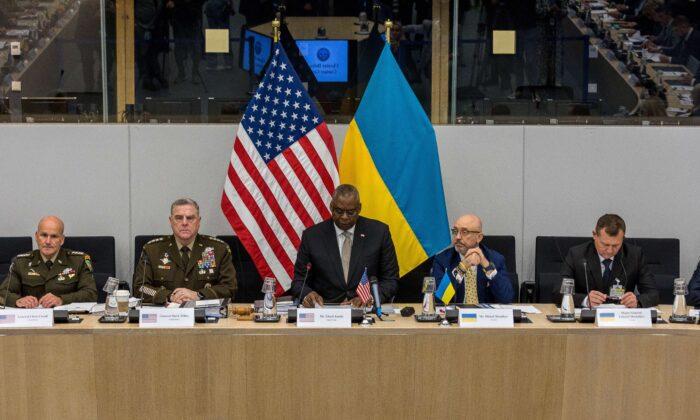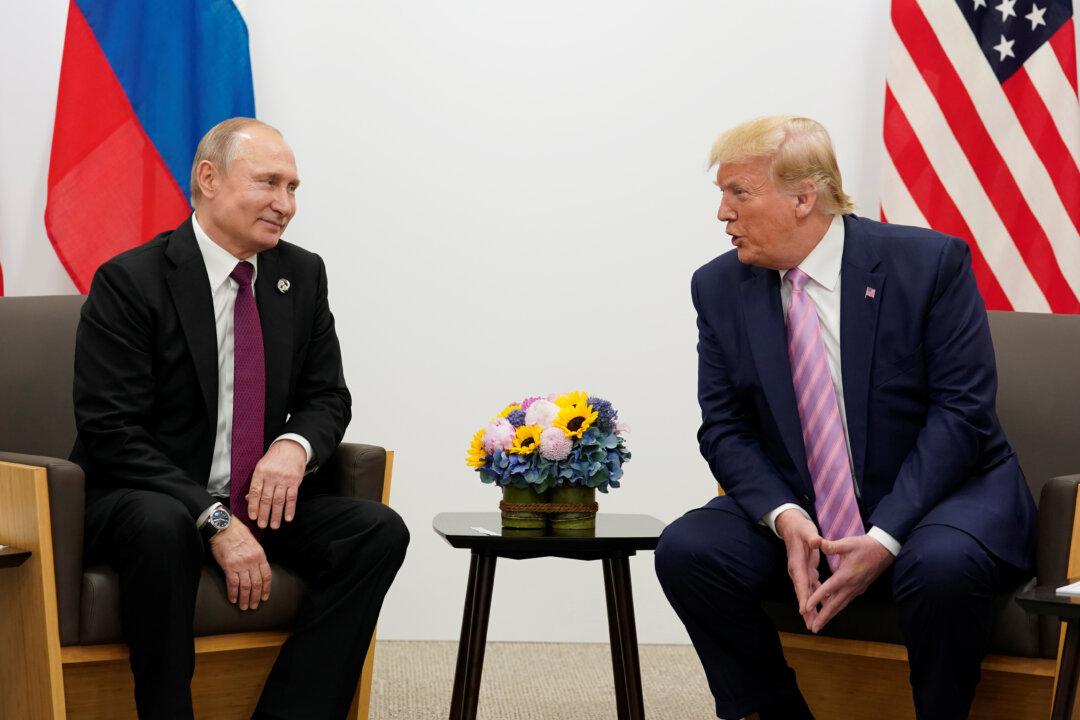Commentary
The longer the war in Ukraine goes on, the less believable the narrative that surrounds it becomes. That doesn’t mean that Russian President Vladimir Putin or Ukrainian President Volodymyr Zelenskyy are without guilt, blame, or fault.
But the Biden administration—or whoever is calling the shots behind the scenes—decided to push the North Atlantic Treaty Organization (NATO) to Russia’s doorstep. Ukraine wasn’t a NATO member when the war broke out, but it may as well have been.
Ukraine: A Client State of the US
Recall that for years before the war, the United States sent defensive arms, such as sophisticated Javelin anti-tank weapons, to Kyiv. But that didn’t prompt Russia to move on Ukraine. Even U.S. financial leverage over Russia via sanctions made life difficult for Russia and wasn’t enough to trigger an invasion.But over time, Ukraine had become what more or less amounted to a U.S. client state. It was hosting bioweapons research laboratories and, of course, working closely with U.S. President Joe Biden and his family in a variety of allegedly corrupt schemes. (And by the way, contrary to the U.S. government’s official narrative, Ukraine looks much less than a “democracy” as it censors speech and closes churches.)
NATO Expansionism Provoked Russia
NATO had other eastward expansion plans that would have encircled Russia by adding even more nations, such as Georgia, into the organization. The plan was—and perhaps remains—to install advanced missiles with nuclear capabilities in countries bordering Russia, threatening its security.
The plenary session where the Finnish Parliament votes on Finland's accession to the North Atlantic Treaty Organization, in Helsinki, Finland, on March 1, 2023. Lehtikuva/Heikki Saukkomaa via Reuters
The Hoover Institution clearly expressed Russia’s viewpoint on NATO expansionism: “If American strategists were not angling for advantage in a prospective nuclear exchange, as Putin believed, why then abandon Minsk II and the principle of Ukrainian neutrality?”
And then suddenly, in 2022, “unprovoked” Russia invaded Ukraine, even though generations of American policymakers have known that Ukrainian inclusion in NATO would result in Russian action.
Not Territory, but Security
Does Russia want more territory? Yes, it does. Is it an aggressive actor on the world stage? Yes. That said, it’s not a simple “territorial dispute” between the two countries as Florida Gov. Ron DeSantis framed it a few days ago.If the situation was turned around, which U.S. administration, barring the current one, of course, would allow Russia to do the same in northern Mexico that the United States has done in Ukraine?
Moreover, Russia views protecting ethnic Russians in Ukraine and other nations as its national responsibility. Rightly or wrongly, capturing the eastern regions of Ukraine was intended to do that.
A Negotiated Peace Lost?
Once that was accomplished, it may have been possible that a ceasefire could have been attained. What would a negotiated peace in the first months of the war look like? Could a neutrality arrangement have been possible? Could eastern Ukrainian regions have been returned to Ukraine in exchange for a NATO withdrawal from that nation?
Poland's president, Andrzej Duda (L), and U.S. President Joe Biden inspect an honor guard during an arrival ceremony at the Presidential Palace in Warsaw on Feb. 21, 2023. Mandel Ngan/AFP via Getty Images
We may never know.
But rather than seeking to simply push Russia back to its 2021 borders or being open to Putin’s overtures for negotiations, the Biden administration declared that NATO’s objective in the war is nothing less than regime change in Russia. This left little wiggle room to end the war quickly and zero motivation for Putin to stop military operations.
In short, the United States has refused Russian negotiation offers and has made it impossible for Putin to agree to any peace deal. NATO’s expansionist policy is now driving the war, not Ukrainian sovereignty.
Will Spring Offensive Widen the War?
That offensive consisted of the United States and NATO countries providing growing amounts of sophisticated weapons that enabled Ukraine to take the war to Russian territory.A spring offensive from Ukraine is widely expected to occur once the ground firms up, but Ukraine faces a 5-to-1 disadvantage in soldiers. Furthermore, Russia can outproduce the United States in armaments, making it unlikely that Ukraine will prevail in this war.
In the meantime, the war is taking its toll on both Russia and Ukraine. Ukrainian cities are in ruins. Millions have fled. Deaths and casualties are in the hundreds of thousands on both sides. Belarus may soon join the fight with Russia, while Poland and Slovakia send fighter jets to Ukraine.
Is This What NATO Expansion Looks Like?
Recall that NATO was created as a defensive organization intended to defend Europe against an invasion by the old Soviet Union. But with the collapse of the USSR in 1991, Central European countries were freed of Russian domination, and NATO’s defensive purpose all but disappeared.In the three decades between the fall of the Soviet Russian empire and Russia’s invasion of Ukraine, NATO had added 14 nations to its ranks, including many former Soviet states in Central and Eastern Europe. It has also engaged Bosnia and Herzegovina, Finland, Georgia, Sweden, and Ukraine as aspiring members as part of its Open Doors expansion plans. There are currently 28 European member nations in NATO.
US Economy Taking Hits as Russia Cruises
But it’s also taking a toll on the West, especially the United States.More than a year after the invasion, Russia has benefitted from higher fuel and grain prices, while the Western nations are paying through the nose and seeing their economies crumble.
The U.S. banking system is closer to collapsing than anyone cares to imagine. And by trillions more in debt since the war began, the U.S. dollar isn’t as popular as it used to be. In fact, some nations want to abandon the dollar altogether. Meanwhile, the Russian ruble has become a favored currency in the world.
But it gets worse.
U.S. sanctions against Russia haven’t had the expected impact. Russian exports have risen to larger nations, such as China and India, as well as smaller regional countries. Russian gross domestic product has dropped only marginally.
Finally, Putin’s responses to NATO’s expansion and Biden’s declarations have been consistent. He has repeatedly warned that the United States risks a nuclear attack from Russia if NATO’s proxy war with Russia is successful.
These warnings have fallen on deaf ears in the White House.
The probability, however, remains that Moscow won’t attack Europe with nukes. But if they’re used at all, they would be aimed at the United States.
It’s high time we ask if NATO’s interests are truly America’s interests.
Views expressed in this article are opinions of the author and do not necessarily reflect the views of The Epoch Times.





